Samsung SSD 860 QVO 1 TB and 4 TB: the first consumer SATA QLC (part 1)
- Transfer
Part 1 >> Part 2 >> Part 3
And the introduction of NAND flash memory with four bits per cell (QLC) continues, as witnessed by the first consumer SATA SSD with Samsung's QLC NAND. The new 860 QVO raises the bar for “entry level” in Samsung’s very successful family of SSD products. Unlike previous budget proposals, such as the 750 EVO and the usual 850, 860 QVO is preparing for mass production and is ready to gain a foothold in the market.
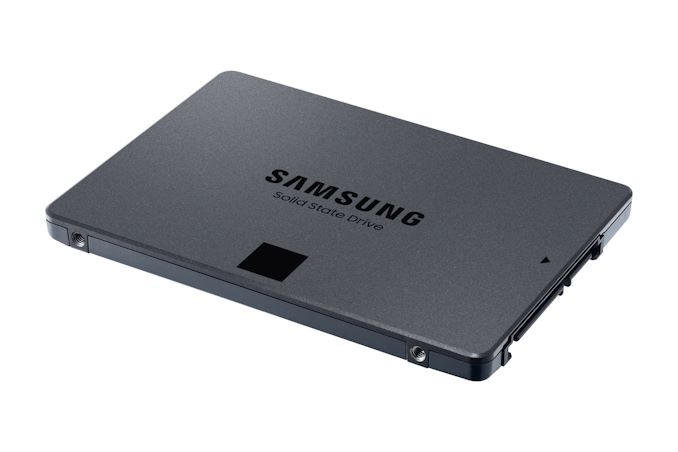
The Samsung 860 QVO is the first model from the new SSD SATA series that can beat the prices of even solid state drives based on DRAM without TLC due to the increased density of the QLC NAND, and the 860 QVO is equipped with a full-sized LPDDR4 DRAM cache.
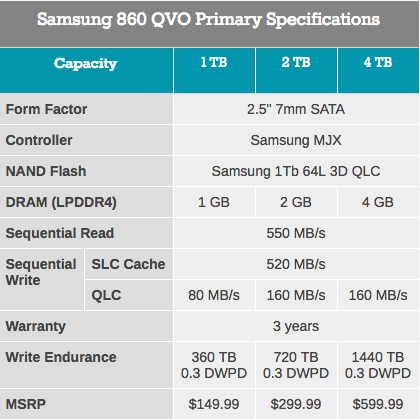
Samsung’s SATA consumer product line now consists of 860 QVO, 860 EVO and 860 PRO. All 860s share a common hardware platform based on the Samsung MJX SSD controller and their 64-layer 3D NAND, and products differ mainly in the number of bits stored in one flash memory cell.
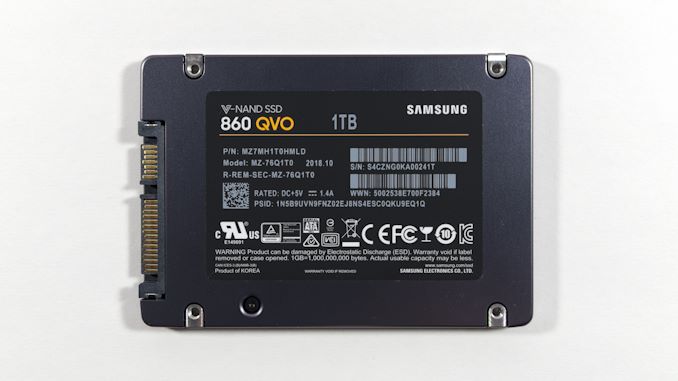
The manufacturer assigns a 860 QVO write resilience rating equivalent to 0.3 "write disc per day" (DWPD). Even for a 1 TB disk, this means 300 GB of recordings per day, which is beyond the needs of most users. The price is set at $ 150 for the smallest model (1 TB), and $ 600 for a model of 4 TB, the cost per GB is the same for the entire range. But it should be noted that the preliminary MSRP for the 860 QVO is not that aggressive, given the record sales we have seen recently in the case of TLC solid-state drives.
The “two-bit” MLC used in the 860 PRO is now quite rare among consumer SSDs and is almost completely absent in modern corporate SSDs, since it has been largely supplanted by the three-bit TLC used in the 860 EVO. With each increase in the number of bits stored in each cell, write performance and endurance decrease, as greater precision is required to distinguish voltage levels, which are now as high as 16 in QLC NAND.
Although improvements to the controller and other improvements to the NAND process (especially the transition from planar to 3D NAND) allowed TLC to overcome almost all of its drawbacks compared to the MLC, they did not expect such success from QLC NAND technology. Early samples of QLC NAND could withstand just a few hundred write / erase cycles, which would lead to the creation of discs requiring a very careful workload, which would ultimately consider QLC as a write-once and read-multiple media (WORM - write-once, read-many). When QLC matured for mass production, the picture changed, and it became clear that QLC NAND would have enough stamina to use as a general purpose storage facility.
Intel and Micron were the first to start shipping their QLC NAND - first in the corporate SATA SSD Micron 5210 ION, and then in the consumer solid-state drives Intel 660p and Crucial P1 M.2 NVMe. Both the 660p and P1 drives introduced QLC NAND on the consumer SSD market, but, like NVMe drives, they were in the premium SSD SATA segment in terms of price. However, as mentioned above, the MSRP introductory prices for the 860 QVO are not particularly aggressive given the TLC record sales. These sales are not only related to the holiday season - flash memory prices are falling overall, because every manufacturer has 64-layer NAND in mass production, and PC and smartphone sales slow down. Meanwhile, there are rumors that the profitability of QLC NAND was very low, and the true cost is close to the cost of TLC, and does not correspond to the “cheapening” of GB by 25%.
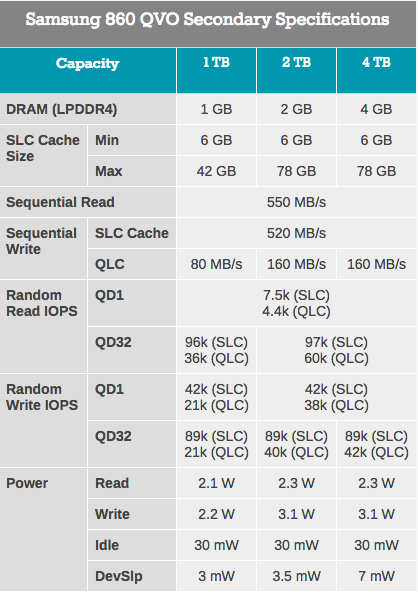
The two main disadvantages of QLC NAND compared to the more common TLC NAND are the speed and endurance of the recording. Both problems can be eliminated by using more NAND in general, which allows for parallel distribution of the record among several NAND matrices. This and (hope of) price cuts make QLC NAND the best choice among high capacity SSDs. As a result, the 860 QVO product line starts with 1 TB. With this volume, only 8 QLC NAND dies are required for the 860 QVO, but it can only support writing at 80 MB / s. This means that the 860 QVO SLC write cache is even more important than with TLC. When running in cache, the 860 QVO can saturate the SATA channel with random or sequential writing. The cache functions almost the same as the SLC cache on the 860 EVO, and has a capacity which varies from a minimum of 6 GB when the disk is relatively full, to 42 GB on 1 TB models or 78 GB on 2 TB and 4 TB models. Intel and Crucial Consumer QLCs also have a variable size SLC cache, but with noticeable limits on the maximum cache size and storage policy in the cache until the drive needs additional space. Unlike competitors, the 860 QVO seems to use a more standard approach to aggressively clearing the cache during idle time to prepare for future bursts of write activity. until the drive needs extra space. Unlike competitors, the 860 QVO seems to use a more standard approach to aggressively clearing the cache during idle time to prepare for future bursts of write activity. until the drive needs extra space. Unlike competitors, the 860 QVO seems to use a more standard approach to aggressively clearing the cache during idle time to prepare for future bursts of write activity.
The performance scores for the 860 QVO when working from the SLC cache roughly correspond to other mainstream SATA SSDs. After filling the cache performance drops significantly, which is especially noticeable in the sequential write. The power consumption is also comparable with other recent Samsung SATA solid-state drives: a little more than 2 W is required for a 1 TB model, and a little more than 3 W for larger models during recording. The 2TB and 4TB models have almost the same performance and power rating, which indicates that 2TB QLC is enough to fill all the NAND channels of the MJX controller.
The warranty period and endurance ratings of the 860 QVO is another area where the negative impact of using QLC NAND is clearly revealed. The 860 QVO warranty period is three years, which is typical for low-cost solid-state drives, and this is less than 5 years warranty, which have 860 EVO and PRO. Lifetime is calculated based on 360 full disk rewriting operations, or 0.3 DWPD over a 3-year warranty. This is comparable to some of the cheaper TLC drives currently on the market, and in terms of the total number of bytes written, a rating of 860 QVO is about 80% higher than that of Intel 660p and Crucial P1, despite the fact that these NVMe QLC drives provide five year warranty.
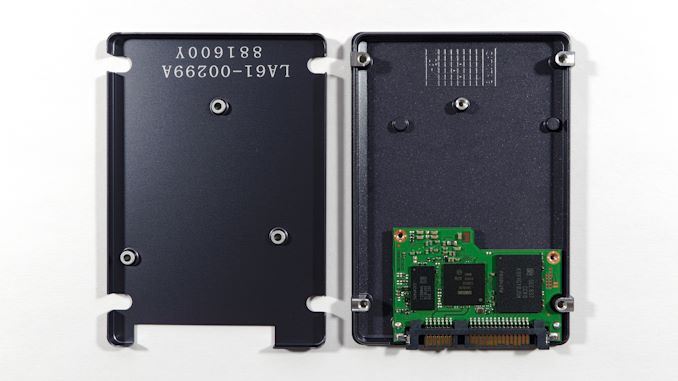
The 860 QVO case has the same simple design as other recent Samsung SATA SSDs, but is painted dark gray instead of the traditional black. From the inside, the 1TB 860 QVO shows how ridiculous the now oversized size of a 2.5-inch drive form looks. The PCB has three large BGA chips: DRAM, a controller, and a stack of eight 1TB QLC. On the back of the case there are empty mounts where you can place another NAND package. Samsung usually packs up to sixteen layers of NAND together, so even 4 TB of QVO could get along with the same small PCB — but placing DRAM becomes a more important issue. Samsung claims that their current MJX controller supports drives up to 8 TB, but it is clear that consumer SSDs with such a large capacity are not specifically in demand. By itself 2, A 5-inch form factor can hold at least 16 TB, or even 32 TB, if two printed circuit boards are folded into a 15-mm thick disc. These opportunities may manifest themselves in corporate products, but, probably, the consumer market of solid-state drives will not see such proposals for several generations.
Samsung has not announced a version of the M60 860 QVO for M.2, but this is quite possible if there is demand. They are likely to be able to place even 4TB 860 QVO on a one-sided 80-mm M.2 card.
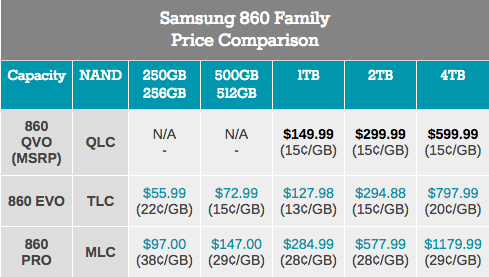
The initial MSRP for the 860 QVO does not look like a “great deal” compared to the existing SATA SSDs on the market. For example, the cost of a gigabyte per 860 EVO is currently 13 cents, versus 15 cents QVO with a capacity of 1 TB and 2 TB. Currently, Samsung has no competitors in the field of 4-TB SATA SSDs, so the GB on their 4 TB 860 EVO is much higher, which makes it possible for the 860 QVO to look cheaper. To become a really strong competitor in the consumer market, a gigabyte on a QVO 860 drive should cost no more than 13 cents, and this limit can be overcome in the next few months, as flash memory prices continue to fall, and the profitability of QLC products is growing.
Samsung provided us with 1 TB and 4 TB samples of 860 QVO. Testing the 1 TB model went smoothly, but the 4TB 860 QVO ran into problems leading to the disappearance of the drive from the system interface. These problems are most noticeable during hot-swappable drives, which is a normal part of our SATA SSD testing procedure. There were also difficulties recognizing the 4TB disk by the motherboard at boot time, with the result that the boot on some systems stopped for an indefinite time.
It should be noted that our test mode is quite complicated, and we sometimes get disk failures. There are problems, but only some of them are specific to a particular disk.
As a result, these problems do not seem to relate to the 860 QVO or its use of the QLC NAND, and were found on both 4TB 860 EVO and 4TB 860 PRO on several host systems, but did not occur in any of the smaller ones. 860's. In addition, 3.84 TB 860 DCT and 4 TB 850 EVO also worked without failures, so this is not a problem with 4 TB solid-state drives in general. We are still working with Samsung to determine the scale and nature of these problems with 4TB drives, and it is unclear whether there is a common compatibility problem or our testing procedure caused a firmware error that caused a hardware failure.
Because of these problems, we have not yet provided some test results for 4 TB drives. Despite the performance and price, I cannot recommend any of the 4TB 860 series SSDs until I can understand the nature of the problems.
There are no other consumer QLC SATA solid-state drives on the market yet, although ADATA has announced its SU630, which will have an inexplicably small amount. Intel 660p and Crucial P1 are the only SSD QLC currently available, but they are designed for the NVMe market. Most of the competition for the 860 QVO will be on SATA SSD with TLC NAND, both on entry-level models with DRAMless controllers (for example, Toshiba TR200) and on more popular models, such as 860 EVO, Crucial MX500 and WD Blue. Almost all SATA SSD product lines have a 1 TB class model, but 2 TB models are still relatively few, and there are no 4 TB competitors announced. Most likely, this will change when there are other QLC drives, and even the 2 TB TLC drives this year have become more common.
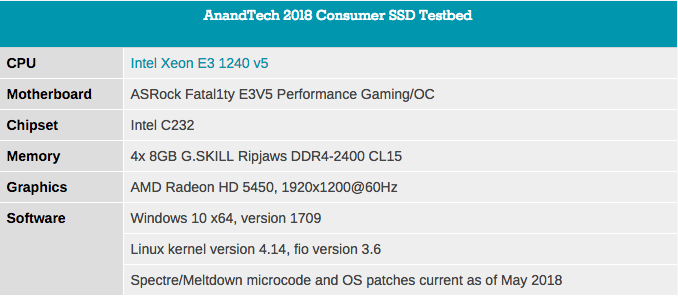
This test runs on a newly cleaned disc, and fills it with a sequential 128 KB record at a depth of 32 queues, recording the recording speed of each 1 GB segment. This test is not an indicator of the usual use of the disc by the consumer, but it allows us to observe changes in the behavior of the disc as it is filled. This can allow us to estimate the size of each SLC write cache, and get an idea of how much performance remains in those rare cases when using it in the real world will result in writing data after filling the cache. Samsung Official Specifications:
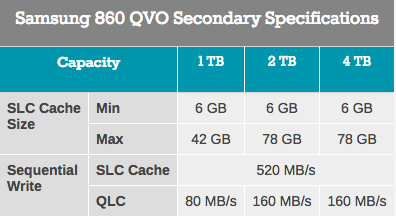
Our results show the following:
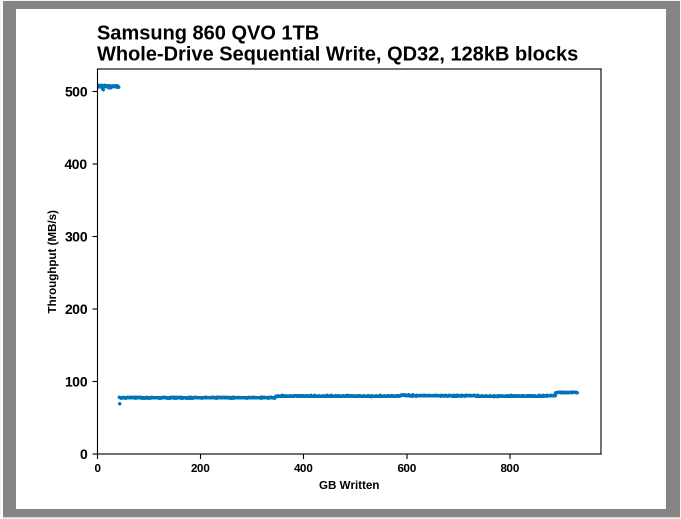
Samsung 860 QVO 1TB

Samsung 860 QVO 4TB

Samsung 850 PRO 1TB
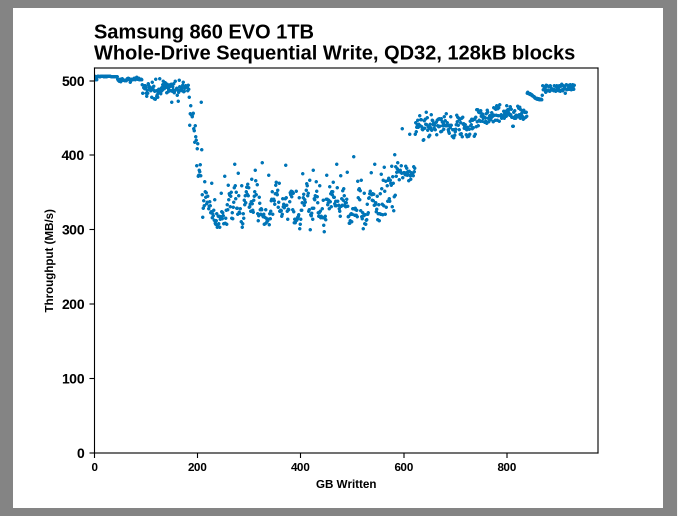
Samsung 860 EVO 1TB
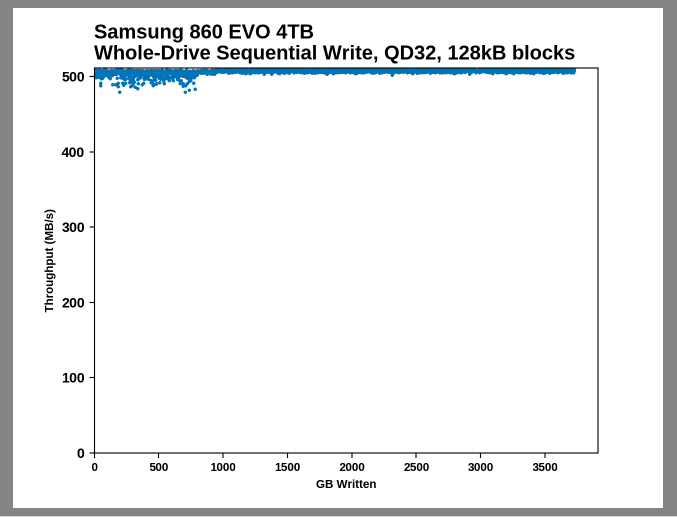
Samsung 860 EVO 4TB
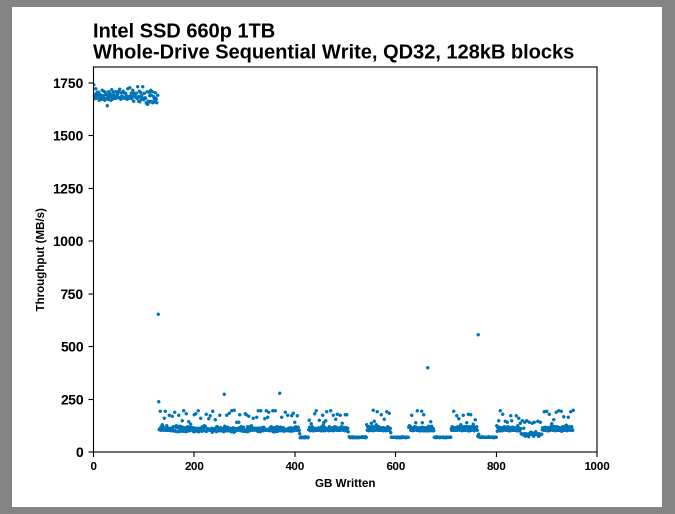
Intel SSD 660p 1TB
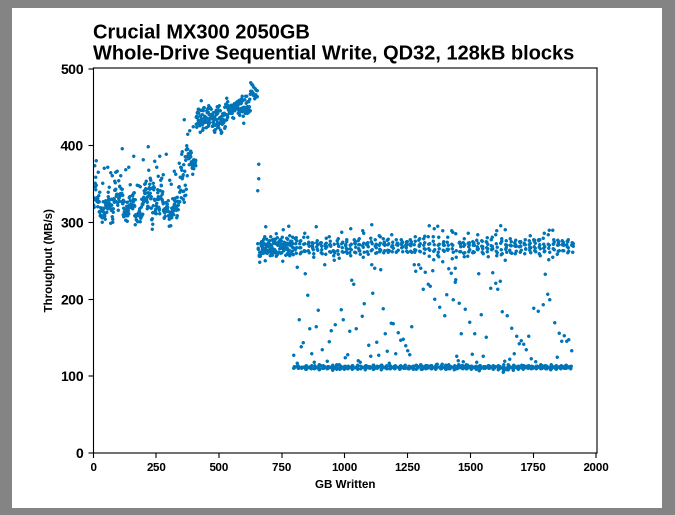
Crucial MX300 2050GB
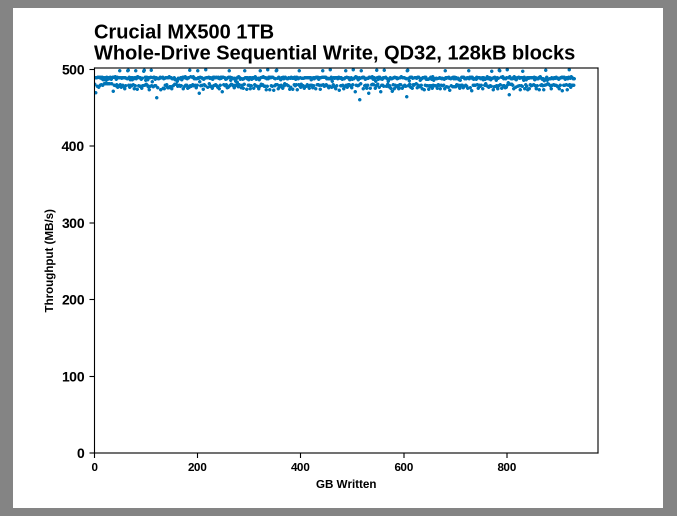
Crucial MX500 1TB
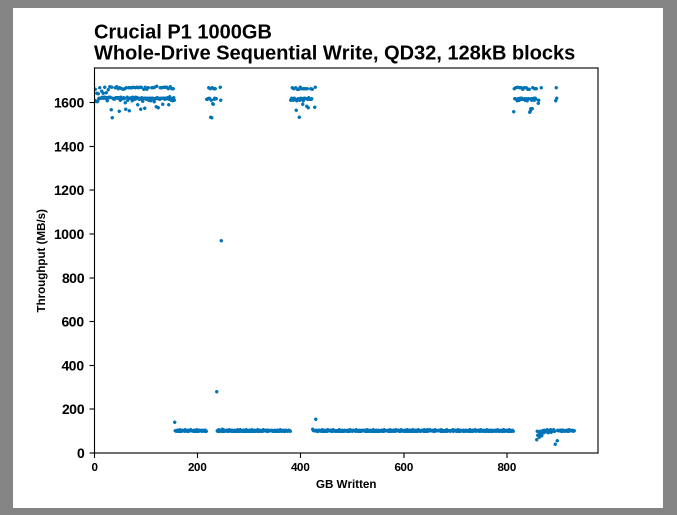
Crucial P1 1000GB
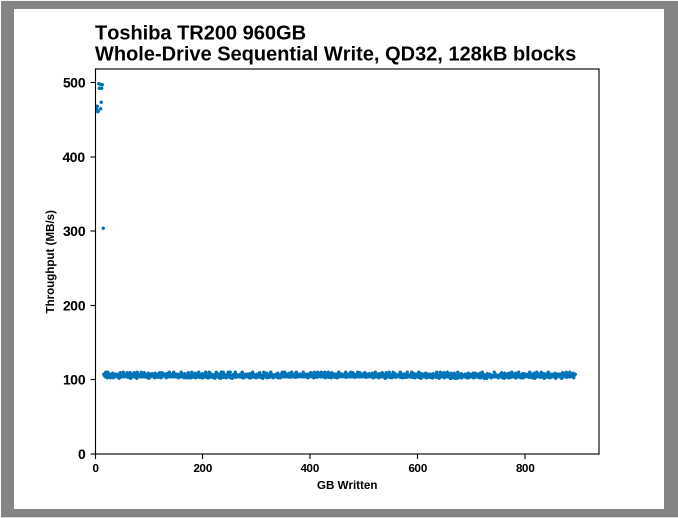
Toshiba TR200 960GB
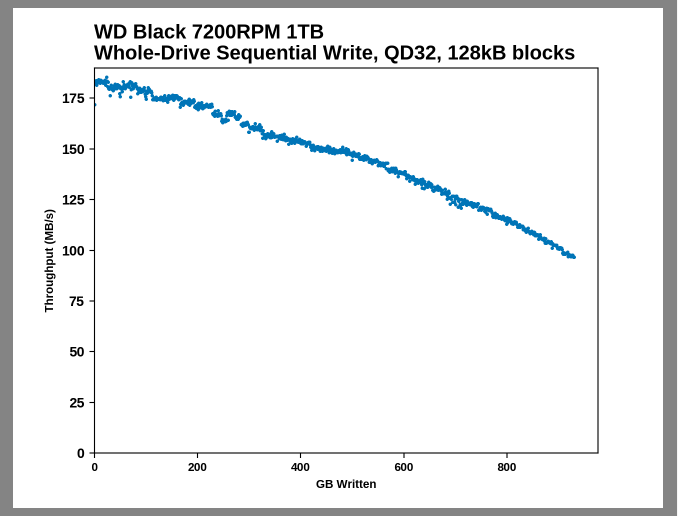
WD Black 7200RPM 1TB

WD Blue 1TB 3D NAND
QVO Samsung 860 exhausts the SLC cache exactly according to the specification, 42 GB for the 1 TB model and 78 GB for the 4 TB model. After that, both devices are very slow, and very stable until the end of the test.


The sequential write speed of 1 TB of 860 QVO drops sharply when the SLC cache is exhausted, but the 4 TB model is capable of maintaining twice the write speed in this situation, and is ahead of the hard drives, but also some of the slower TLC.
BAPCo's SYSmark 2018 is an application-based benchmark that uses real-world applications to reproduce the activity of business users, and determines the indicators of productivity, creativity and responsiveness. The results reflect the overall system performance and are calibrated against a reference system, the performance of which is defined as 1000 in each of the scenarios. Evaluating, say, 2000, will mean that the system under test is twice as fast as the reference system.
The SYSmark estimate is based on the overall response time of the application that the user sees, including not only the storage delay, but also the time spent by the processor. This means that there is a limit to how much drive improvement can increase points, because the SSD is used only for a small part of the total test duration. This is a significant difference from our ATSB tests, where only the disk workload is displayed, and the idle time of the disk is reduced to 25 ms.

In testing SSD using SYSmark, we used a different system than in the rest of our SSD tests. This machine is configured to measure the overall power consumption of the system, not just the drive power.
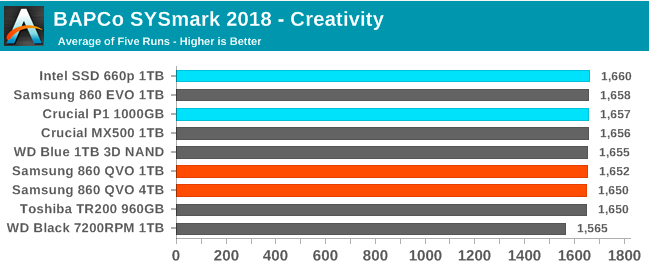

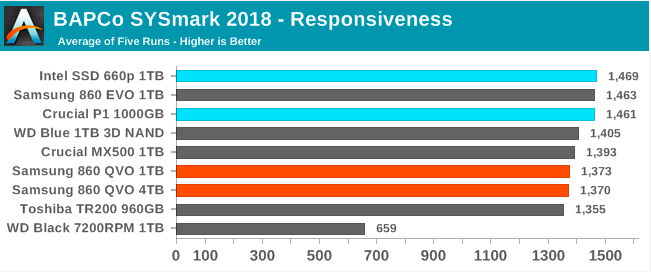
The QVO 860 does not lag behind other disks in the case of complex computational problems, and even in the test, depending on the I / O speed, the QVO 860 is ahead of the DRAMless TLC drive and is not far behind the Crucial MX500.
The SYSmark benchmark estimates and measures the total power consumption of the system, with the exception of the display. Our test system for SYSmark consumes at idle about 26 W, and reaches peak values of more than 60 W of power, measured during the performance test. SATA solid-state drives rarely consume more than 5 watts, and when idle, the watt share, and SSD conduct most of the test in idle time. This means that energy use indicators will inevitably be very close. A typical notebook system is better optimized for energy efficiency than our desktop system, so SSD consumption will be a much larger part of the total, and the difference in performance between SSDs will be more noticeable.

The power consumption of the Samsung 860 QVO during SYSmark revealed no problems, since it consumes slightly less than regular SATA TLC drives.
Destroyer is a very long test that repeatedly repeats access operations for very intensive use of I / O. As with actual use, drives sometimes get a break, which allows for background garbage collection and cache cleaning, but idle time is limited to 25 ms, so running the test does not take a whole week. Our AnandTech Storage Bench (ATSB) tests do not include running real-world applications that generated workloads, so test results are almost insensitive to changes in the CPU and RAM performance of our new test bench, but switching to a newer version of Windows and more recent drivers may change the result.

We estimate the performance in this test by reporting the average disk throughput, the average I / O latency and the total energy used by the disk during the test.
The terabyte Samsung 860 QVO doesn’t do much with the Destroyer, showing an average data transfer rate slightly lower than that of TLC without DRAM. For comparison, NVMe QLC drives from Intel and Micron are only slightly slower than 860 EVO and MX500.
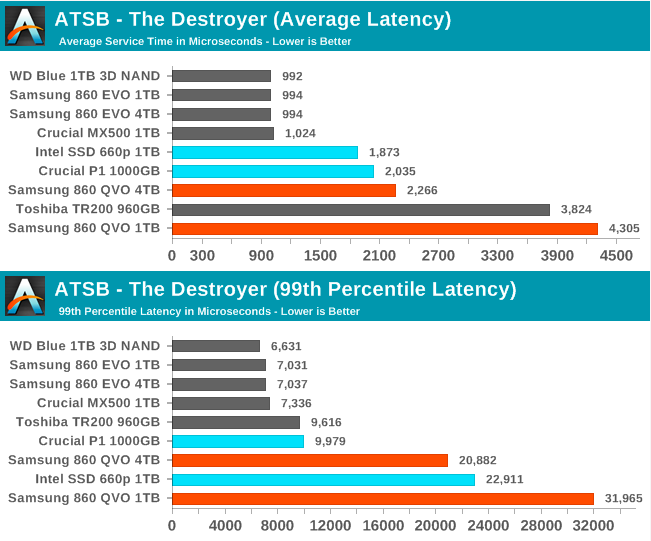
The QLC drives showed themselves even worse in latency than in the throughput test. Especially noticeable when the graph in the 99th percentile. The 1TB 860 QVO ranks last in both the average delay and the delay of the 99th percentile, and all three QLC drives have the worst 99th percentile delay than the DRAMless TLC drive.
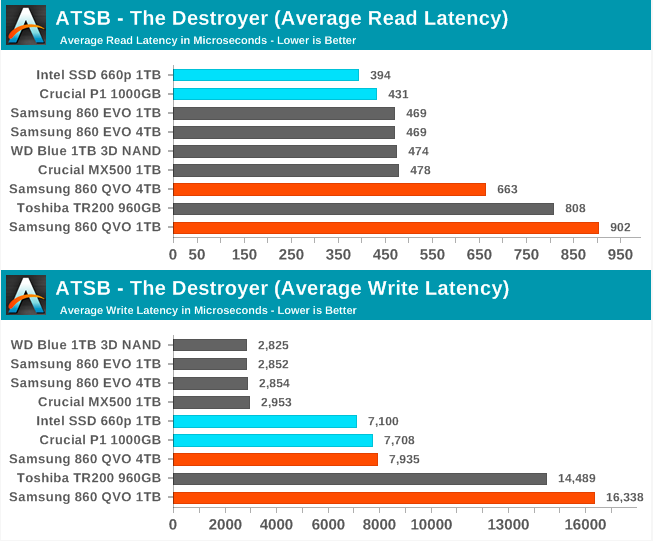
The average read and write latency of the 860 QVO is only slightly worse than the DRAMless TLC SSD. NVMe QLC drives are slightly faster in read latency than mainstream SATA drives, but lag behind in average write latency.
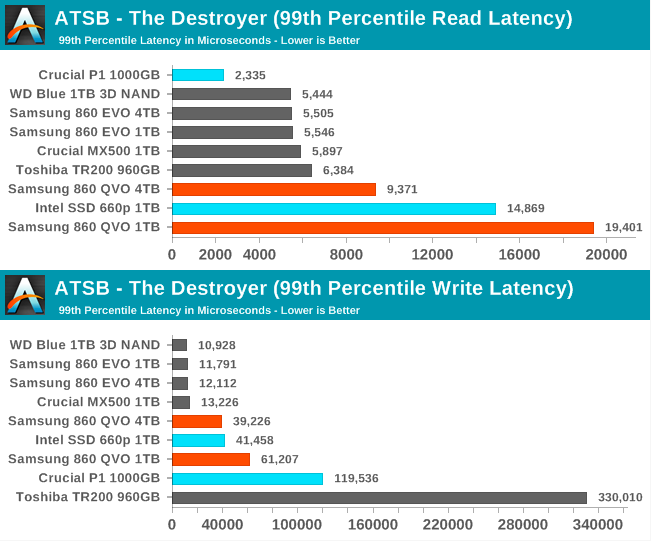
Still, QVO 860 was not in last place in the test of the 99th percentile of the write delay, and even much better performance than the DRAMless TLC drive. However, all QLC drives are much worse than regular TLC SATA drives.
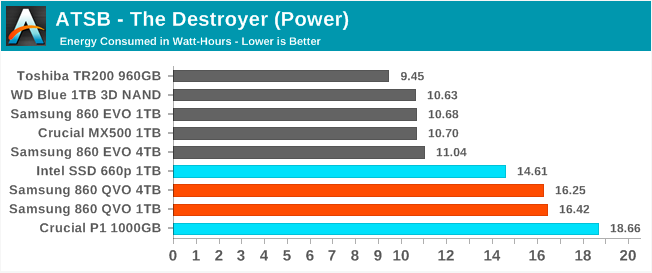
Given the low performance, which stretches the long test for an even longer period, it is not surprising that all QLC drives consume much more power during work with the Destroyer than most SATA drives. The Toshiba TR200 DRAMless is an impressive exception that manages to be very effective, despite its low overall performance.
Our test drive Heavy gives a much larger recording load than the Destroyer, but much shorter in time. The number of records in the test is not enough to fill the drive, so performance never drops to a stable state. This test is much more revealing for everyday use, and is particularly affected by peak drive performance. This test is run twice, once on the newly cleaned disc, and once after the disc is filled with sequential recording.
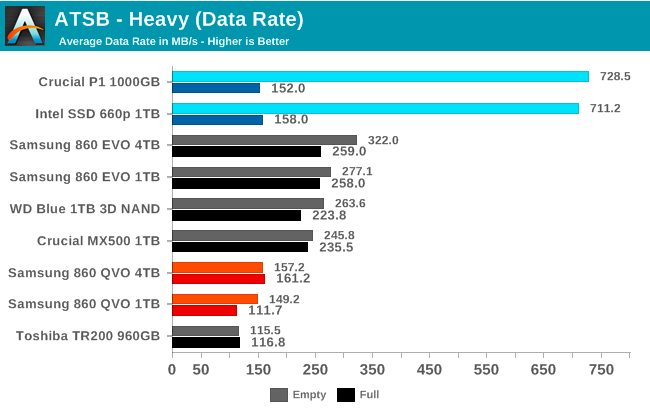
None of the Samsung 860 QVOs can match the regular TLC drives in the intensive recording test, but they both outperform the DRAMless TLC drive. The NVMe + QLC drives from Intel and Micron work much better when the test is performed on an empty disk, but when filled, they also lag behind the main TLC SSD.


The Samsung 860 QVO latency is much worse than conventional TLC drives, and the 99th percentile delay is even worse than even the DRAMless TLC SSD. Nevertheless, the Samsung QLC drives performed slightly better than the Intel / Micron QLC when the test was run on a full disk.

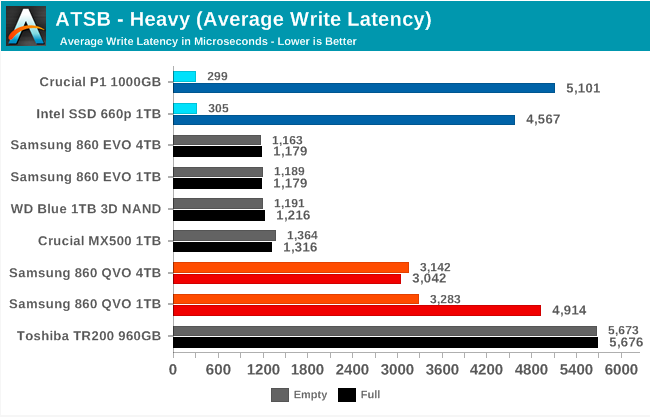
The average reading delay from QVO Samsung 860 only slightly loses to conventional TLC drives, but the average recording delay is at least two times worse.

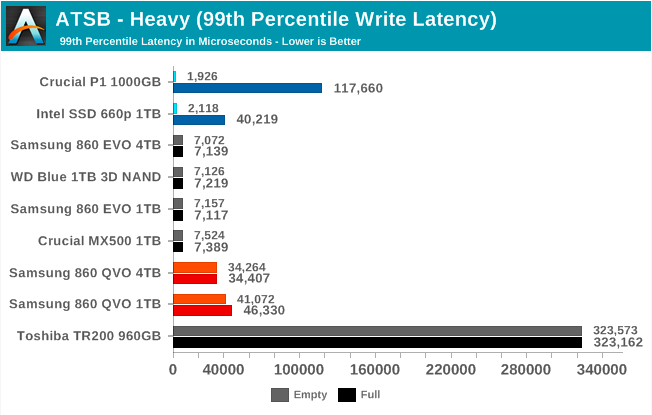
The read and write latency rates in the 99th percentile from 860 QVO are bad. But they, at least, do not have terrifying QoS problems with the recordings that the Toshiba TR200 shows, and are better than recording on a full-sized Crucial P1 drive.
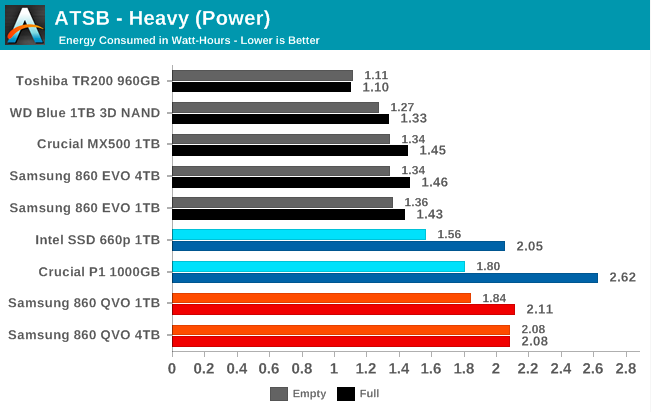
The Samsung 860 QVO consumes significantly more power during the Heavy test than other SATA drives, and almost always more than NVMe QLC drives.
The Light accumulator test has more sequential hits and a shorter queue depth than The Destroyer or Heavy, it is the shortest test. It is mainly based on applications that are not particularly dependent on the performance of the storage, so basically it is a test of the time of launching applications and downloading files. The test can be considered as the sum of all small delays with daily use, but with less downtime to 25 ms, testing takes less than half an hour. As in the case of the ATSB Heavy test, this test is performed with an empty disk, and after filling the disk with consecutive records.

The Samsung 860 QVO has no problems with the Light test when it starts up on an empty disk, and the performance loss of all-wheel drive is not that great: 1TB 860 QVO stays ahead of the TLC DRAMless drive even when the disk is full.

The average delay and the 99th percentile from the 860 QVO look good when the test is performed on an empty drive. Delays are significantly higher when drives are full, but better than on Intel / Micron QLC drives.

The average read and write latency of the 860 QVO is clearly worse than the performance of TLC disks when tested with a full disk, but, in fact, we have seen similar indicators on TLC more slowly.

The 99th reading latency percentile at 860 QVO is a sore point when the drive is full, but at least the write delay does not get out of control like the other two QLC drives.
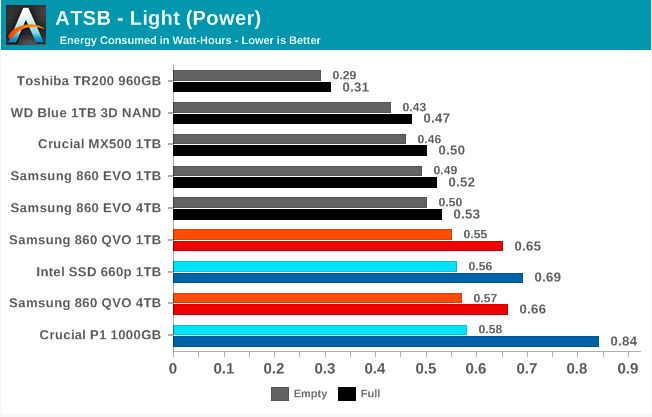
All QLC drives consume more power than TLC drives during the Light test, especially when they are full, and they need to do more background work.
Thank you for staying with us. Do you like our articles? Want to see more interesting materials? Support us by placing an order or recommending to friends, 30% discount for Habr's users on a unique analogue of the entry-level servers that we invented for you: The whole truth about VPS (KVM) E5-2650 v4 (6 Cores) 10GB DDR4 240GB SSD 1Gbps from $ 20 or how to share the server?(Options are available with RAID1 and RAID10, up to 24 cores and up to 40GB DDR4).
VPS (KVM) E5-2650 v4 (6 Cores) 10GB DDR4 240GB SSD 1Gbps until January 1 for free if you pay for a period of six months, you can order here .
Dell R730xd 2 times cheaper? Only we have 2 x Intel Dodeca-Core Xeon E5-2650v4 128GB DDR4 6x480GB SSD 1Gbps 100 TV from $ 249 in the Netherlands and the USA! Read about How to build an infrastructure building. class c using servers Dell R730xd E5-2650 v4 worth 9000 euros for a penny?
And the introduction of NAND flash memory with four bits per cell (QLC) continues, as witnessed by the first consumer SATA SSD with Samsung's QLC NAND. The new 860 QVO raises the bar for “entry level” in Samsung’s very successful family of SSD products. Unlike previous budget proposals, such as the 750 EVO and the usual 850, 860 QVO is preparing for mass production and is ready to gain a foothold in the market.

Samsung 860 QVO
The Samsung 860 QVO is the first model from the new SSD SATA series that can beat the prices of even solid state drives based on DRAM without TLC due to the increased density of the QLC NAND, and the 860 QVO is equipped with a full-sized LPDDR4 DRAM cache.

Samsung’s SATA consumer product line now consists of 860 QVO, 860 EVO and 860 PRO. All 860s share a common hardware platform based on the Samsung MJX SSD controller and their 64-layer 3D NAND, and products differ mainly in the number of bits stored in one flash memory cell.

The manufacturer assigns a 860 QVO write resilience rating equivalent to 0.3 "write disc per day" (DWPD). Even for a 1 TB disk, this means 300 GB of recordings per day, which is beyond the needs of most users. The price is set at $ 150 for the smallest model (1 TB), and $ 600 for a model of 4 TB, the cost per GB is the same for the entire range. But it should be noted that the preliminary MSRP for the 860 QVO is not that aggressive, given the record sales we have seen recently in the case of TLC solid-state drives.
MLC vs. TLC vs. QLC: why Q matters
The “two-bit” MLC used in the 860 PRO is now quite rare among consumer SSDs and is almost completely absent in modern corporate SSDs, since it has been largely supplanted by the three-bit TLC used in the 860 EVO. With each increase in the number of bits stored in each cell, write performance and endurance decrease, as greater precision is required to distinguish voltage levels, which are now as high as 16 in QLC NAND.
Although improvements to the controller and other improvements to the NAND process (especially the transition from planar to 3D NAND) allowed TLC to overcome almost all of its drawbacks compared to the MLC, they did not expect such success from QLC NAND technology. Early samples of QLC NAND could withstand just a few hundred write / erase cycles, which would lead to the creation of discs requiring a very careful workload, which would ultimately consider QLC as a write-once and read-multiple media (WORM - write-once, read-many). When QLC matured for mass production, the picture changed, and it became clear that QLC NAND would have enough stamina to use as a general purpose storage facility.
Intel and Micron were the first to start shipping their QLC NAND - first in the corporate SATA SSD Micron 5210 ION, and then in the consumer solid-state drives Intel 660p and Crucial P1 M.2 NVMe. Both the 660p and P1 drives introduced QLC NAND on the consumer SSD market, but, like NVMe drives, they were in the premium SSD SATA segment in terms of price. However, as mentioned above, the MSRP introductory prices for the 860 QVO are not particularly aggressive given the TLC record sales. These sales are not only related to the holiday season - flash memory prices are falling overall, because every manufacturer has 64-layer NAND in mass production, and PC and smartphone sales slow down. Meanwhile, there are rumors that the profitability of QLC NAND was very low, and the true cost is close to the cost of TLC, and does not correspond to the “cheapening” of GB by 25%.

The two main disadvantages of QLC NAND compared to the more common TLC NAND are the speed and endurance of the recording. Both problems can be eliminated by using more NAND in general, which allows for parallel distribution of the record among several NAND matrices. This and (hope of) price cuts make QLC NAND the best choice among high capacity SSDs. As a result, the 860 QVO product line starts with 1 TB. With this volume, only 8 QLC NAND dies are required for the 860 QVO, but it can only support writing at 80 MB / s. This means that the 860 QVO SLC write cache is even more important than with TLC. When running in cache, the 860 QVO can saturate the SATA channel with random or sequential writing. The cache functions almost the same as the SLC cache on the 860 EVO, and has a capacity which varies from a minimum of 6 GB when the disk is relatively full, to 42 GB on 1 TB models or 78 GB on 2 TB and 4 TB models. Intel and Crucial Consumer QLCs also have a variable size SLC cache, but with noticeable limits on the maximum cache size and storage policy in the cache until the drive needs additional space. Unlike competitors, the 860 QVO seems to use a more standard approach to aggressively clearing the cache during idle time to prepare for future bursts of write activity. until the drive needs extra space. Unlike competitors, the 860 QVO seems to use a more standard approach to aggressively clearing the cache during idle time to prepare for future bursts of write activity. until the drive needs extra space. Unlike competitors, the 860 QVO seems to use a more standard approach to aggressively clearing the cache during idle time to prepare for future bursts of write activity.
The performance scores for the 860 QVO when working from the SLC cache roughly correspond to other mainstream SATA SSDs. After filling the cache performance drops significantly, which is especially noticeable in the sequential write. The power consumption is also comparable with other recent Samsung SATA solid-state drives: a little more than 2 W is required for a 1 TB model, and a little more than 3 W for larger models during recording. The 2TB and 4TB models have almost the same performance and power rating, which indicates that 2TB QLC is enough to fill all the NAND channels of the MJX controller.
The warranty period and endurance ratings of the 860 QVO is another area where the negative impact of using QLC NAND is clearly revealed. The 860 QVO warranty period is three years, which is typical for low-cost solid-state drives, and this is less than 5 years warranty, which have 860 EVO and PRO. Lifetime is calculated based on 360 full disk rewriting operations, or 0.3 DWPD over a 3-year warranty. This is comparable to some of the cheaper TLC drives currently on the market, and in terms of the total number of bytes written, a rating of 860 QVO is about 80% higher than that of Intel 660p and Crucial P1, despite the fact that these NVMe QLC drives provide five year warranty.

The 860 QVO case has the same simple design as other recent Samsung SATA SSDs, but is painted dark gray instead of the traditional black. From the inside, the 1TB 860 QVO shows how ridiculous the now oversized size of a 2.5-inch drive form looks. The PCB has three large BGA chips: DRAM, a controller, and a stack of eight 1TB QLC. On the back of the case there are empty mounts where you can place another NAND package. Samsung usually packs up to sixteen layers of NAND together, so even 4 TB of QVO could get along with the same small PCB — but placing DRAM becomes a more important issue. Samsung claims that their current MJX controller supports drives up to 8 TB, but it is clear that consumer SSDs with such a large capacity are not specifically in demand. By itself 2, A 5-inch form factor can hold at least 16 TB, or even 32 TB, if two printed circuit boards are folded into a 15-mm thick disc. These opportunities may manifest themselves in corporate products, but, probably, the consumer market of solid-state drives will not see such proposals for several generations.
Samsung has not announced a version of the M60 860 QVO for M.2, but this is quite possible if there is demand. They are likely to be able to place even 4TB 860 QVO on a one-sided 80-mm M.2 card.

The initial MSRP for the 860 QVO does not look like a “great deal” compared to the existing SATA SSDs on the market. For example, the cost of a gigabyte per 860 EVO is currently 13 cents, versus 15 cents QVO with a capacity of 1 TB and 2 TB. Currently, Samsung has no competitors in the field of 4-TB SATA SSDs, so the GB on their 4 TB 860 EVO is much higher, which makes it possible for the 860 QVO to look cheaper. To become a really strong competitor in the consumer market, a gigabyte on a QVO 860 drive should cost no more than 13 cents, and this limit can be overcome in the next few months, as flash memory prices continue to fall, and the profitability of QLC products is growing.
A note about our testing: random disk failure
Samsung provided us with 1 TB and 4 TB samples of 860 QVO. Testing the 1 TB model went smoothly, but the 4TB 860 QVO ran into problems leading to the disappearance of the drive from the system interface. These problems are most noticeable during hot-swappable drives, which is a normal part of our SATA SSD testing procedure. There were also difficulties recognizing the 4TB disk by the motherboard at boot time, with the result that the boot on some systems stopped for an indefinite time.
It should be noted that our test mode is quite complicated, and we sometimes get disk failures. There are problems, but only some of them are specific to a particular disk.
As a result, these problems do not seem to relate to the 860 QVO or its use of the QLC NAND, and were found on both 4TB 860 EVO and 4TB 860 PRO on several host systems, but did not occur in any of the smaller ones. 860's. In addition, 3.84 TB 860 DCT and 4 TB 850 EVO also worked without failures, so this is not a problem with 4 TB solid-state drives in general. We are still working with Samsung to determine the scale and nature of these problems with 4TB drives, and it is unclear whether there is a common compatibility problem or our testing procedure caused a firmware error that caused a hardware failure.
Because of these problems, we have not yet provided some test results for 4 TB drives. Despite the performance and price, I cannot recommend any of the 4TB 860 series SSDs until I can understand the nature of the problems.
Race for leadership
There are no other consumer QLC SATA solid-state drives on the market yet, although ADATA has announced its SU630, which will have an inexplicably small amount. Intel 660p and Crucial P1 are the only SSD QLC currently available, but they are designed for the NVMe market. Most of the competition for the 860 QVO will be on SATA SSD with TLC NAND, both on entry-level models with DRAMless controllers (for example, Toshiba TR200) and on more popular models, such as 860 EVO, Crucial MX500 and WD Blue. Almost all SATA SSD product lines have a 1 TB class model, but 2 TB models are still relatively few, and there are no 4 TB competitors announced. Most likely, this will change when there are other QLC drives, and even the 2 TB TLC drives this year have become more common.

Fill the entire disk: testing the SLC cache
This test runs on a newly cleaned disc, and fills it with a sequential 128 KB record at a depth of 32 queues, recording the recording speed of each 1 GB segment. This test is not an indicator of the usual use of the disc by the consumer, but it allows us to observe changes in the behavior of the disc as it is filled. This can allow us to estimate the size of each SLC write cache, and get an idea of how much performance remains in those rare cases when using it in the real world will result in writing data after filling the cache. Samsung Official Specifications:

Our results show the following:

Samsung 860 QVO 1TB

Samsung 860 QVO 4TB

Samsung 850 PRO 1TB

Samsung 860 EVO 1TB

Samsung 860 EVO 4TB

Intel SSD 660p 1TB

Crucial MX300 2050GB

Crucial MX500 1TB

Crucial P1 1000GB

Toshiba TR200 960GB

WD Black 7200RPM 1TB

WD Blue 1TB 3D NAND
QVO Samsung 860 exhausts the SLC cache exactly according to the specification, 42 GB for the 1 TB model and 78 GB for the 4 TB model. After that, both devices are very slow, and very stable until the end of the test.


The sequential write speed of 1 TB of 860 QVO drops sharply when the SLC cache is exhausted, but the 4 TB model is capable of maintaining twice the write speed in this situation, and is ahead of the hard drives, but also some of the slower TLC.
BAPCo SYSmark 2018
BAPCo's SYSmark 2018 is an application-based benchmark that uses real-world applications to reproduce the activity of business users, and determines the indicators of productivity, creativity and responsiveness. The results reflect the overall system performance and are calibrated against a reference system, the performance of which is defined as 1000 in each of the scenarios. Evaluating, say, 2000, will mean that the system under test is twice as fast as the reference system.
The SYSmark estimate is based on the overall response time of the application that the user sees, including not only the storage delay, but also the time spent by the processor. This means that there is a limit to how much drive improvement can increase points, because the SSD is used only for a small part of the total test duration. This is a significant difference from our ATSB tests, where only the disk workload is displayed, and the idle time of the disk is reduced to 25 ms.

In testing SSD using SYSmark, we used a different system than in the rest of our SSD tests. This machine is configured to measure the overall power consumption of the system, not just the drive power.



The QVO 860 does not lag behind other disks in the case of complex computational problems, and even in the test, depending on the I / O speed, the QVO 860 is ahead of the DRAMless TLC drive and is not far behind the Crucial MX500.
Power consumption
The SYSmark benchmark estimates and measures the total power consumption of the system, with the exception of the display. Our test system for SYSmark consumes at idle about 26 W, and reaches peak values of more than 60 W of power, measured during the performance test. SATA solid-state drives rarely consume more than 5 watts, and when idle, the watt share, and SSD conduct most of the test in idle time. This means that energy use indicators will inevitably be very close. A typical notebook system is better optimized for energy efficiency than our desktop system, so SSD consumption will be a much larger part of the total, and the difference in performance between SSDs will be more noticeable.

The power consumption of the Samsung 860 QVO during SYSmark revealed no problems, since it consumes slightly less than regular SATA TLC drives.
AnandTech Destroyer
Destroyer is a very long test that repeatedly repeats access operations for very intensive use of I / O. As with actual use, drives sometimes get a break, which allows for background garbage collection and cache cleaning, but idle time is limited to 25 ms, so running the test does not take a whole week. Our AnandTech Storage Bench (ATSB) tests do not include running real-world applications that generated workloads, so test results are almost insensitive to changes in the CPU and RAM performance of our new test bench, but switching to a newer version of Windows and more recent drivers may change the result.

We estimate the performance in this test by reporting the average disk throughput, the average I / O latency and the total energy used by the disk during the test.
The terabyte Samsung 860 QVO doesn’t do much with the Destroyer, showing an average data transfer rate slightly lower than that of TLC without DRAM. For comparison, NVMe QLC drives from Intel and Micron are only slightly slower than 860 EVO and MX500.

The QLC drives showed themselves even worse in latency than in the throughput test. Especially noticeable when the graph in the 99th percentile. The 1TB 860 QVO ranks last in both the average delay and the delay of the 99th percentile, and all three QLC drives have the worst 99th percentile delay than the DRAMless TLC drive.

The average read and write latency of the 860 QVO is only slightly worse than the DRAMless TLC SSD. NVMe QLC drives are slightly faster in read latency than mainstream SATA drives, but lag behind in average write latency.

Still, QVO 860 was not in last place in the test of the 99th percentile of the write delay, and even much better performance than the DRAMless TLC drive. However, all QLC drives are much worse than regular TLC SATA drives.

Given the low performance, which stretches the long test for an even longer period, it is not surprising that all QLC drives consume much more power during work with the Destroyer than most SATA drives. The Toshiba TR200 DRAMless is an impressive exception that manages to be very effective, despite its low overall performance.
AnandTech Heavy
Our test drive Heavy gives a much larger recording load than the Destroyer, but much shorter in time. The number of records in the test is not enough to fill the drive, so performance never drops to a stable state. This test is much more revealing for everyday use, and is particularly affected by peak drive performance. This test is run twice, once on the newly cleaned disc, and once after the disc is filled with sequential recording.

None of the Samsung 860 QVOs can match the regular TLC drives in the intensive recording test, but they both outperform the DRAMless TLC drive. The NVMe + QLC drives from Intel and Micron work much better when the test is performed on an empty disk, but when filled, they also lag behind the main TLC SSD.


The Samsung 860 QVO latency is much worse than conventional TLC drives, and the 99th percentile delay is even worse than even the DRAMless TLC SSD. Nevertheless, the Samsung QLC drives performed slightly better than the Intel / Micron QLC when the test was run on a full disk.


The average reading delay from QVO Samsung 860 only slightly loses to conventional TLC drives, but the average recording delay is at least two times worse.


The read and write latency rates in the 99th percentile from 860 QVO are bad. But they, at least, do not have terrifying QoS problems with the recordings that the Toshiba TR200 shows, and are better than recording on a full-sized Crucial P1 drive.

The Samsung 860 QVO consumes significantly more power during the Heavy test than other SATA drives, and almost always more than NVMe QLC drives.
AnandTech Light
The Light accumulator test has more sequential hits and a shorter queue depth than The Destroyer or Heavy, it is the shortest test. It is mainly based on applications that are not particularly dependent on the performance of the storage, so basically it is a test of the time of launching applications and downloading files. The test can be considered as the sum of all small delays with daily use, but with less downtime to 25 ms, testing takes less than half an hour. As in the case of the ATSB Heavy test, this test is performed with an empty disk, and after filling the disk with consecutive records.

The Samsung 860 QVO has no problems with the Light test when it starts up on an empty disk, and the performance loss of all-wheel drive is not that great: 1TB 860 QVO stays ahead of the TLC DRAMless drive even when the disk is full.

The average delay and the 99th percentile from the 860 QVO look good when the test is performed on an empty drive. Delays are significantly higher when drives are full, but better than on Intel / Micron QLC drives.

The average read and write latency of the 860 QVO is clearly worse than the performance of TLC disks when tested with a full disk, but, in fact, we have seen similar indicators on TLC more slowly.

The 99th reading latency percentile at 860 QVO is a sore point when the drive is full, but at least the write delay does not get out of control like the other two QLC drives.

All QLC drives consume more power than TLC drives during the Light test, especially when they are full, and they need to do more background work.
Thank you for staying with us. Do you like our articles? Want to see more interesting materials? Support us by placing an order or recommending to friends, 30% discount for Habr's users on a unique analogue of the entry-level servers that we invented for you: The whole truth about VPS (KVM) E5-2650 v4 (6 Cores) 10GB DDR4 240GB SSD 1Gbps from $ 20 or how to share the server?(Options are available with RAID1 and RAID10, up to 24 cores and up to 40GB DDR4).
VPS (KVM) E5-2650 v4 (6 Cores) 10GB DDR4 240GB SSD 1Gbps until January 1 for free if you pay for a period of six months, you can order here .
Dell R730xd 2 times cheaper? Only we have 2 x Intel Dodeca-Core Xeon E5-2650v4 128GB DDR4 6x480GB SSD 1Gbps 100 TV from $ 249 in the Netherlands and the USA! Read about How to build an infrastructure building. class c using servers Dell R730xd E5-2650 v4 worth 9000 euros for a penny?
